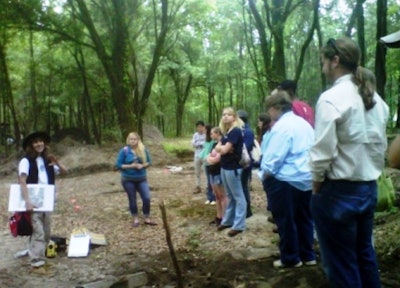 Archaeologist Rita Elliott discusses the Miller Plantation with students from Georgia Southern University.
Archaeologist Rita Elliott discusses the Miller Plantation with students from Georgia Southern University.Behind the towering Live Oak trees in the Savannah suburb of Georgetown, crews of archaeologists recently unearthed the brown and red dirt for signs that slaves once lived there. They found physical evidence of how slaves on the Miller Plantation lived and the tools they used around the kitchen in everyday life, including fragments of dishes, white and blue ceramics and green glass.
Such artifacts can breathe life into the pages of history, says Daina Ramey Berry, a scholar of American slavery at the University of Texas in Austin who has studied slavery in the region.
“For me as a historian, I learn more about slavery from a toilet or a trash pit. I can use the archaeological report as a physical record. It’s very powerful,” Berry said.
The archaeological discovery by the Georgia Department of Transportation was triggered by the National Historic Preservation Act of 1966, a federal law that requires archaeological digs on public land in historically significant areas. The landowner in this case is the Georgia DOT, which purchased the property from a private landowner for a highway project known as the Abercorn Extension.
If not in the hands of the state, the wooded area, which sits along Highway 204 next to a newly built apartment complex and convenience store, may likely be bulldozed and developed.
Rita Elliott, the public archaeologist for One South Associates, the company hired to do the dig for the Georgia DOT, told a group of college students from Georgia Southern University recently that the company sectioned off about 20-acres using X-ray-type technology to spot potential structures. They were given a few months and limited resources to survey the land and to unearth what they could before the highway construction project begins.
According to the plans, everything but a 400-year-old live oak and four 200-year-old live oaks will be turned into a highway round-a-bout.
The physical evidence from the slave quarters were sifted, boxed and preserved as artifacts by archaeologist from New South for a new collection at the University of West Georgia, said Pam Baughman, an archaeological consultant hired to supervise that part of the project.
“We want our collection to rise to the standards of the University of Georgia in Athens and West Georgia,” said Baughman. Student workers at West Georgia can benefit from learning about cataloging and the analysis process. The materials will be made “available in the future to university researchers and others.” The collection will also be available on loan for museums and library displays.
The site is already attracting interest from college students. Earlier this month, Georgia Southern University archaeology and history professor Sue Moore took a group of her undergraduate and graduate students to see the work underway. Elliott showed the students signs of the footprints left by plows, the outlining area of structures and the pits that will be sifted and studied. The red brick stones from several chimneys excited the group and hundreds of others who say they want to know more about the history.
Miller’s plantation is historically significant for a number of reasons. Savannah Attorney William H. Miller owned 87 slaves by 1860, making him one of the largest slave owners in the state. During the Civil War, The Union’s 3rd Division, a unit of the 15th Army Corps, was headquartered at the nearby Miller’s Station (No.1) train depot. The Union soldiers camped at his plantation for several nights.
The Fight to Preserve History
Though Chatham County, the home of historic Savannah, is known for preserving its historic buildings, it does not have laws on the books to force private developers to preserve physical evidence of its plantation heritage using archeology.
“Chatham County is really dedicated to history, [but] there’s a lot of history that’s being lost,” said Baughman.
“Ultimately, that highway project has to go there,” Baughman added. “We will recover all the data we can and host public outreach events. This [highway] project needed to happen. That intersection is unsafe.”
In other parts of South Georgia, plantations such as Wormsloe and Lebanon have made it into the National Registry of Historic Places. Though many buildings carry that designation, there are few historic places where slaves once lived that have been turned into museums. There is a fear that other historically significant places underground might be plowed.
“There is nothing requiring private landowners to protect its archeology. We destroy it every day,” said Ellen Harris, the cultural resource and urban planning manager at Chatham County-Savannah Metropolitan Planning Commission.
Since the 1980s, the MPC has held discussions about creating an archaeological preservation ordinance. But the subject gets buried because it’s perceived as being “anti-business,” Harris said. There is not a local consensus that the African-American part of Savannah-Chatham County history should be preserved, she added. “If you asked Historic Savannah, they’d say they are saving the buildings. We must tie archeology and slavery. There is a link there. Archeology unveils slaves, immigrants and all of those people who didn’t have the magnificent buildings that rich people had. Archeology is the best way to understand and study the culture of disenfranchised people,” said Harris.
Few historical places across the United States memorialize any aspect of slavery that doesn’t involve the preservation of buildings owned by White landowners, researchers say. Many of the buildings occupied by slaves were made of shacks. “Those structures are hard to find,” said Terry Brock, a doctoral student at Michigan State University who is studying slave structures in St. Mary’s City in Southern Maryland, about 100 miles away from Washington, D.C.
The dearth in remaining slave structures make the work that archaeologists do around the country, and particularly in the South, more important, said Brock.
Joseph McGill, a field officer for the National Trust for Historic Preservation in Charleston, started The Slave Dwelling Project three years ago to raise awareness that former slave structures should be preserved for future generations. According to McGill, preservation efforts for African-American history are slow to mushroom because “some people are not comfortable with that conversation, both Black and White…
“African-Americans have been treated differently in history,” he added. “If not for some White man [being] declared a hero, such as James Madison and Thomas Jefferson, we might not have the places we have. Instead of getting mad, I decided to do something.”


















